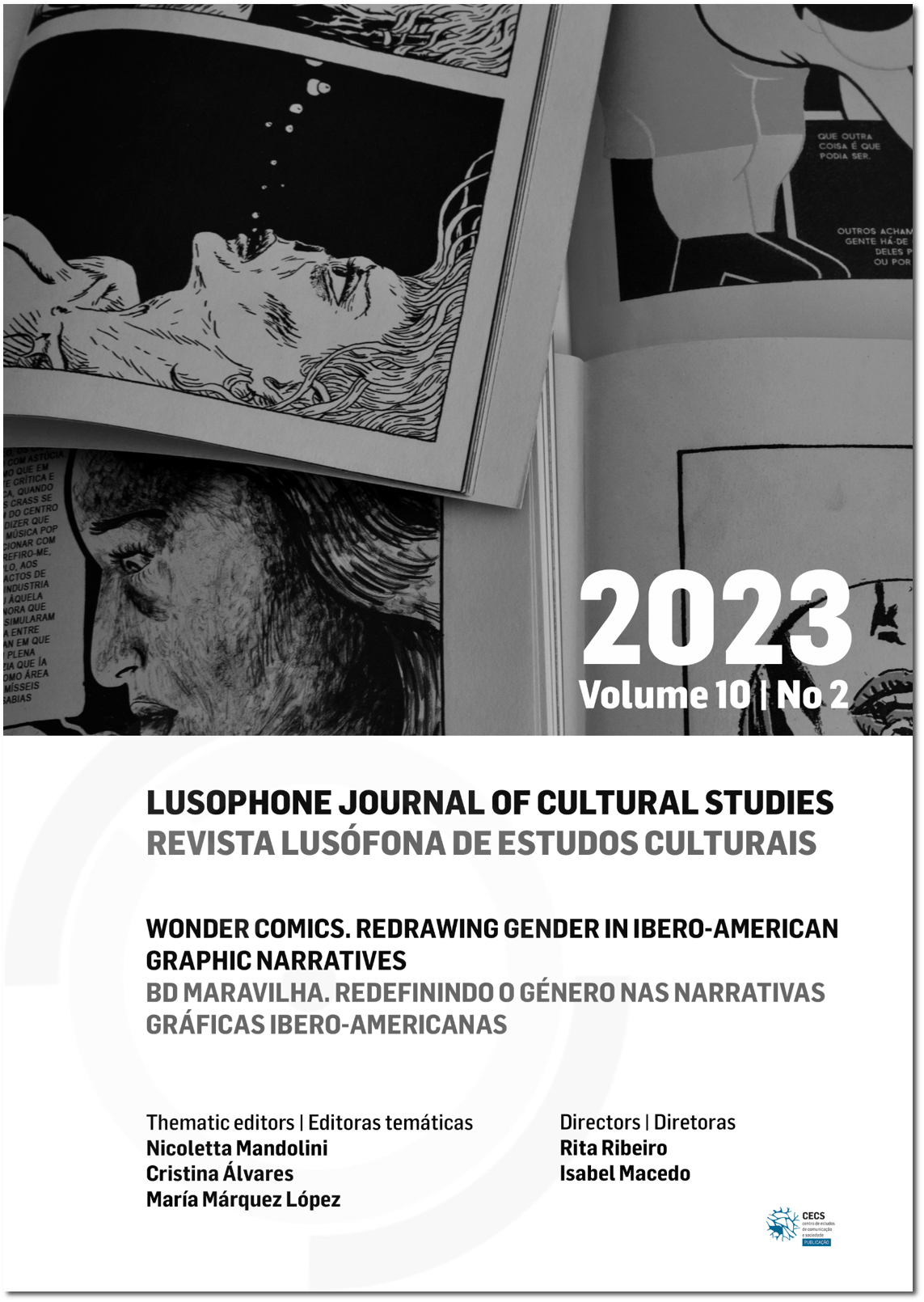There’s a Monster in My Mirror: An Analysis of the Autobiographical Graphic Novel Monstrans: Experimenting with Horrormones, by Lino Arruda
DOI:
https://doi.org/10.21814/rlec.4696Keywords:
monstrosity, self-representation, transsexuality, comicsAbstract
This article seeks to debate the construction of queer narratives in alternative forms of language, such as comics, by compiling relevant literature within the theoretical scopes of gender studies, art history and comics. Autobiographical comics offer countless possibilities for reflection because they incorporate visual elements into the narrative construction. When it comes to an autobiographical illustration, readers have a glimpse of how the artist views themselves in their memories and what they propose to expose. To explore the potential for interpreting and analysing queer autobiographical comics, this discussion centres on the graphic novel Monstrans: Experimentando Horrormônios (Monstrans: Experimenting with Horrormones) by Lino Arruda (2021). This work features deformed watercolour lines that construct the narrative of the author’s memories in his journey to understanding his gender identity. The intention is to reflect on the theme of monstrosity present in this work and how it can be a stylistic resource and a means of critiquing the self-representation of dissident bodies, focussing specifically on the artist’s relationship with the mirror, a recurring element in other transvestite/trans comics also mentioned in this article.
Downloads
References
Anzaldúa, G. (2012). Borderlands/La Frontera: The new mestiza. Aunt Lute Books.
Arruda, L. A. (2020). Monstrans: Figurações (in)humanas na autorrepresentação travesti/trans sudaca [Tese de doutoramento, Universidade Federal de Santa Catarina]. Repositório Institucional UFSC. https://repositorio.ufsc.br/handle/123456789/216221
Arruda, L. A.(2021) Monstrans: Experimentando horrormônios. Edição do Autor.
Braga, A. X., Jr., & Nogueira, N. A. S. (2020). Gênero, sexualidade e feminismo nos quadrinhos. Editora Aspas.
Bulla, V. M. (2018). Tirinhas, alívio cômico e a identidade de gênero em transição: Hugo e Muriel no mundo imaginário de Laerte. Transverso, 6(6), 31–52.
Carneiro, M. C. S. R. (2021). O corpo em tiras: Ficções e autoficções transgêneras nas tiras de Laerte Coutinho. Revista Brasileira de Literatura Comparada, 23(44), 62–77. https://doi.org/10.1590/2596- 304x20212344mcsrc DOI: https://doi.org/10.1590/2596-304x20212344mcsrc
Carvalho, J. C. F. A. (2018). Estranhas e admiráveis singularidades da natureza – Alguns exemplos (séculos XVI-XVIII). In J. C. F. A. Carvalho & A. A. S. Carvalho (Eds.), O monstruoso na literatura e outras artes. Centro de Literaturas e Culturas Lusófonas e Europeias.
Coutinho, L. (2005). Hugo para principiantes. Editora Devir.
Creed, B. (2007). The monstrous-feminine: Film, feminism, psychoanalysis. Routledge.
Fumettibrutti. (2022). Minha Adolescência Trans. Editora Skript (A. Braga; M. S. Rodrigues, Trad.). (Trabalho original publicado em 2019)
García, S. (2012). A novela gráfica (M. Lopes, Trad.). Editora Martins Fontes. (Trabalho original publicado em 2010)
Jaquet, C. (2014). Les ~transclasses, ou la non-reproduction. PUF. DOI: https://doi.org/10.3917/puf.jaqu.2014.01
Kristeva, J. (1980). Poderes do horror: Ensaio sobre a abjeção (A. D. S. Sena, Trad.). Éditions du Seuil.
Mandolini, N. (2022). Transmediality against transphobia: The politics of transsexual self-portraiture in Fumettibrutti’s work between comics and photography. New Readings, 18, 88–108. https://doi.org/10.18573/newreadings.121 DOI: https://doi.org/10.18573/newreadings.121
Moreau, D., & Machado, L. (2020). História dos quadrinhos: EUA. Editora Skript.
Pereira, A. (2019). Pequenas felicidades trans. Edição da Autora.
Pires, M. C. F. P. (2021). Transexualidade em quadrinhos: Narrativa autobiográfica nas histórias de Sasha, a leoa de juba e Alice Pereira. Anos 90, 28, 2–21. https://doi.org/10.22456/1983-201X.110580 DOI: https://doi.org/10.22456/1983-201X.110580
Preciado, P. B. (2021). Eu sou o monstro que vos fala (S. W. York, Trad.). Cadernos PET de Filosofia, 22(1), 278–331. https://doi.org/10.5380/petfilo.v22i1.88248 DOI: https://doi.org/10.5380/petfilo.v22i1.88248
Prins, B., & Meijer, I. C. (2002). Como os corpos se tornam matéria: Entrevista com Judith Butler. Ponto de Vista: Revista de Estudos Feministas, 10(1), 155–167. https://doi.org/10.1590/S0104-026X2002000100009 DOI: https://doi.org/10.1590/S0104-026X2002000100009
Soares, A. I. (2018). Demasiado humano – A familiaridade do monstro. In J. C. F. A. Carvalho & A. A. S. Carvalho (Eds.), O monstruoso na literatura e outras artes. Centro de Literaturas e Culturas Lusófonas e Europeias.
The Metropolitam Museum of Art. (s.d.). Plate 43 from “Los Caprichos”: The sleep of reason produces monsters (el sueño de la razon produce monstruos). Retirado a 1 de julho de 2023 de https://www.metmuseum.org/art/collection/search/338473
Theodoro, H. (2016). Visibilidades midiáticas e transgeneridade: Apontamentos sobre um estudo de caso com Laerte Coutinho. Revista Dito Efeito, 7(11), 30–42. https://doi.org/10.3895/rde.v7n11.5016 DOI: https://doi.org/10.3895/rde.v7n11.5016
Vargas, A. L. (2015). A invenção dos quadrinhos: Teoria e crítica da sarjeta [Tese de doutoramento, Universidade Federal de Santa Catarina]. Repositório Institucional UFSC. https://repositorio.ufsc.br/xmlui/handle/123456789/135497
Vargas, A. L. (2016). A invenção dos quadrinhos autorais: Uma breve história da arte da segunda metade do século XX. História, Histórias, 4(7), 25–37. https://doi.org/10.26512/hh.v4i7.10924 DOI: https://doi.org/10.26512/hh.v4i7.10924
Vitorelo. (2022). A monstruosa potência de ser trans. Revista Mina de HQ, (3), 33–35.
Zouvi, A. (2020). O espaço autobiográfico nos quadrinhos queer brasileiros. In E. Irineu, G. Borges, & G. Smee (Eds.), Quadrinhos queer (pp.15-17). Editora Skript.
Downloads
Published
How to Cite
Issue
Section
License
Copyright (c) 2023 Camila Lelis, Marcus Antônio Assis Lima

This work is licensed under a Creative Commons Attribution 4.0 International License.
Authors own the copyright, providing the journal with the right of first publication. The work is licensed under a Creative Commons - Atribuição 4.0 Internacional License.












